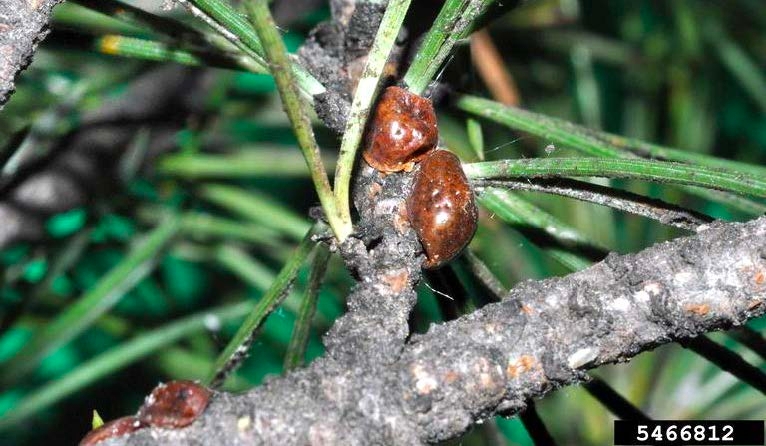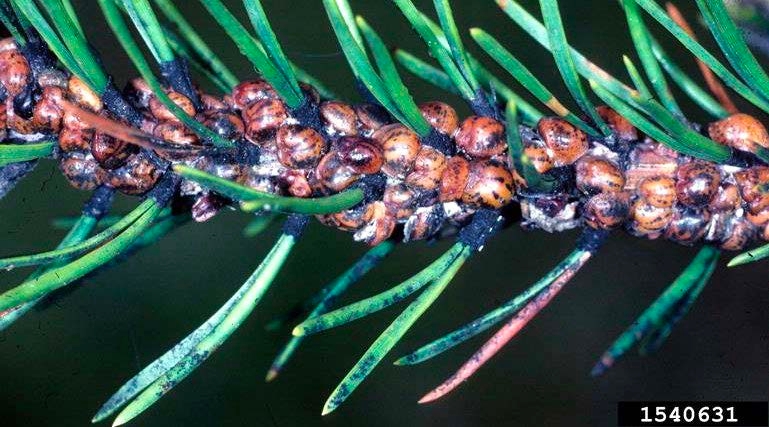Pine Tortoise Scale
ID
3104-1529 (ENTO-466NP)
Introduction
Pine tortoise scale, Toumeyella parvicornis, is a soft scale native to the United States. It attacks various species of 2- and 3-needled pines, including Scotch, jack, loblolly, mugo, red, Austrian, and Virginia (Fig. 1). Pine tortoise scale belongs in the family Coccidae in the order Hemiptera.

Identification
Mature female pine tortoise scales are large, reddish-brown, highly convex, oval-shaped insects (Fig. 1 & 2). Their name comes from their appearance of small turtles attached to young twigs.
Life History
Pine tortoise scale overwinters as immature but mated females that reach maturity by early June. Adult females may lay 500 eggs, which hatch into crawlers from mid-June to early July (Fig. 3). The crawlers settle on young twigs or sometimes on needles. Male pine tortoise scale insects develop quickly into winged adults. They mate with the developing females soon after emergence and then die. Mated females continue to develop and overwinter. There is usually one generation per year in Virginia, although a second generation may be produced if the weather is favorable.


Damage
Pine tortoise scale prefers to feed on newer growth. Infested twigs lose needles, needles may be shorter than normal, and overall growth of the tree may be stunted. Trees may die after several years of heavy infestation. Seedlings and young saplings are most susceptible. Black sooty mold, growing on the honeydew produced by the scale insects, may discolor the branches (Fig. 2). Landscape pines attacked by pine tortoise scale have reduced aesthetic value. Pine tortoise scale reduces the economic value of pines grown in nurseries and as Christmas trees.
Control
Pine tortoise scale is commonly attacked by predators and parasites, which often keep it in check. Populations may become damaging when the scale insects are protected by ants farming them for honeydew, or when insecticide use reduces the presence of beneficial predators and parasites.
Maintain overall plant health and reduce plant stress. Avoid overfertilization. Prune heavily infested branches and burn or otherwise destroy. Do not leave pruned infested material underneath the trees. Inspect new plants and buy only pest-free plants. When possible, increase distance between plants to reduce the spread of crawlers to healthy, uninfested plants.
If control is warranted, use dormant oil in late winter to smother the overwintering females. Dormant oil may remove the waxy bloom from glaucous specimens with blue-green foliage. If the opportunity to apply a dormant oil treatment is missed, insecticidal sprays can be made during the crawler emergence, usually starting in mid to late June.
Homeowners should consult the current Virginia Pest Management Guide for Home Grounds and Animals (VCE PMG 018) for current control recommendations for pine tortoise scale. Commercial growers, including Christmas tree growers, should see the Virginia Pest Management Guide for Horticultural and Forest Crops (VCE PMG 017) for scouting recommendations and additional control measures for pine tree tortoise scale.
Remarks
The striped pine scale, Toumeyella pini, is a related species that also occurs in Virginia and may be mistaken for pine tortoise scale. Control measures for striped pine scale are the same as for pine tortoise scale.
Revised
Theresa A. Dellinger, October 25, 2021.
Virginia Cooperative Extension materials are available for public use, reprint, or citation without further permission, provided the use includes credit to the author and to Virginia Cooperative Extension, Virginia Tech, and Virginia State University.
Virginia Cooperative Extension is a partnership of Virginia Tech, Virginia State University, the U.S. Department of Agriculture (USDA), and local governments, and is an equal opportunity employer. For the full non-discrimination statement, please visit ext.vt.edu/accessibility.
Publication Date
November 22, 2021



